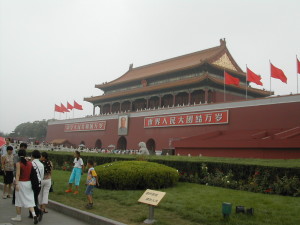Studying Chinese Characters
 Older sisters helping younger sisters brush their hair and prepare for the day’s activities.
Older sisters helping younger sisters brush their hair and prepare for the day’s activities.The various elements that one must remember when learning characters are:
- The written form– Note that some traditional characters have more than one written form.
- In addition, some traditional characters will even have more than one written form and also have an additional simplfied form (or multiple simplified forms) that in Táiwān may often be used only when cursively hand-writing the character.
- These simplified forms may or may not be the same as the simplified form of the character used in China.
- Note also that some words (of one or more characters), may serve as noun, verb, adjective and/or adverb, depending on use and context.
- In China, simplified characters usually have only one variant for each character, but here, too, there will be exceptions.
- The stroke order– When learning to write a character, the order of written strokes is an important aspect of the writing process, as is the exact number of strokes used. A stroke is any line made in printing (as opposed to cursively writing) a character, without lifting the writing implement.
- The pronunciation– Some characters have more than one pronunciation, which sometimes depends on meaning. For the foreigner learning Chinese, learning the pronunciation means learning the Pinyin (or Bopomofo) transliterations, and using them as pronunciation models.
- The tone– Characters will sometimes also use different tones depending on the particular meaning intended.
- The meaning– Note that single characters often have more than one meaning, some have many. So too, character pairs (that is, words made up of 2 characters,) may also have more than one meaning in Chinese.
The Structure of Characters
Characters may be physically structured in many different ways. Characters are classified as either unitary or compound. If you imagine the character to be a square box, for the compound characters the box may subdivided in half in two parts, left and right, or top and bottom:
| left-right | 師/师 | shī | teacher; master; specialist | n. |
| top-bottom | 空 | kōng | empty; sky | n. |
Or, again for compound characters, the box may be divided vertically into thirds, or it may be divided top and bottom, with the top part further divided in half or thirds, and the bottom half also sometimes may be divided:
| left-right into thirds | 懶/懒 | lǎn | lazy | adj. |
| left-right into thirds | 嫩 | nèn | tender | n. |
| top-bottom with top in thirds | 彎/弯 | wān | bend; curve | n. | top-bottom with top in thirds | 戀/恋 | liàn | love | v. |
Each of these subdivisions or parts of the ‘box’ may contain one or more radicals, or a number of unique strokes.
These are just a few of many possibilities for the writing of characters (or for the innovating of new ones to be added to the character set).
Other Possible Character Configurations
⿰ ⿱ ⿲ ⿳ ⿴ ⿵ ⿶ ⿷ ⿸ ⿹ ⿺ ⿻
Represented above are figures showing a dozen different possible Chinese character configurations that are used for characters.
Contextual Learning and the Logic of Chinese
Certainly, learning the spoken language is hard enough for foreigners. The written language is, however, not as difficult as it may seem on its face.
This is because characters are learned in a context, and the context makes each bit of knowledge fit into place, until the learner has a sufficient corpus of knowledge to make further learning seem to be an ‘easy fit’.
Don’t let the task scare you into thinking that it is too complex. It is true that learning Chinese is more difficult than learning Western languages like French, Spanish or Italian.
Even German and Russian, difficult as they are, are probably less difficult: but once the learner establishes a base of knowledge in Chinese, further accretion of knowledge fits into place seamlessly.
Chinese people are very proud of their language …one reason is because they feel that their language is a very logical, well-connected language. While in some ways they are correct, perhaps they are so knowledgeable about the language that they overlook many of the inconsistencies and illogicalities that it also contains.
No matter, all native speakers ‘see the logic’ of their native languages and tend to overlook the illogical aspects of them. It is the subjective impression of this writer that, in fact, Chinese people are correct: their language is highly logical. (See ‘Grammar’ for some of the reasons that it is not as hard as it seems at first.)
Mention has already been made about the possible number of definitions attached to each character. While this does make rote memorization of characters complex, the rote memorization of thirty or forty definitions of a character is not how the characters are actually learned.
Functionally, each character is learned in a context …either in the context of a word, a sentence, or a subject. Chinese is a highly contextual language. The context will act as a cue for the learner as to which meaning of the character is being used in any particular situation.
 A peaceful section of the Li River in Guǎngxī province.
A peaceful section of the Li River in Guǎngxī province.
When that character is encountered in a different context, a new additional definition will be added to the first …and so on in a slow building process until the character has many meanings and is very familiar and is automatically understood correctly.
Bottom line, however, is that if you want to know characters, you have to use them frequently. You have to write them, read them and focus on them to absorb enough to actually function in the Chinese language in Chinese society …if that is your goal.
The Process of Learning Characters
All programs for students of Chinese as a foreign language initiate the process of teaching characters immediately. There is a logic to this: the large number of characters that must be mastered in order to become proficient in the language, and the necessity to become immersed in the language being just two reasons. Learning to speak first, and then going back to begin the process of learning to read and write is NOT an effective method of learning the language.
If you go to China to study, there will be an expectation that your reading, writing and speaking/listening comprehension skills are all in synch with each other. All programs in China expect second year students to have achieved a certain level of ability in the language, and so on up to full fluency with the language. Each year of study brings a certain expectation of proficiency in all areas of the language (on the part of the educational institutions. Your placement in classes will be based on a composite of your abilities in all areas.)
So, when you begin to study the language, expect to immediately begin to learn reading, writing, and speaking/listening at the same time.
Stroke Order and Writing Characters
Writing characters is also a somewhat complex art to learn. Chinese characters are written according to rules of stroke order.
All Chinese writing textbooks will first detail the rules of stroke order in a prefatory note. Only infrequently will these rules be broken, but, be assured that there will be cases that break the rules.
There are (depending upon what classification system is being used,) between 28 and 32 basic strokes used in the writing of Chinese characters, not counting transformed and attached strokes. In general, characters are written from upper right to lower left, with horizontal lines (usually) written before vertical lines.
Each character will have its own well-defined stroke order. In fact, early Chinese electronic dictionaries usually only recognized a handwritten character if written in the proper stroke order, although more modern character entry systems used on cellphones allow much more leeway with cursively written characters.
Memorization By Repeatedly Writing Characters
All students of Chinese (including ‘native speakers’,) learn (ie. ‘memorize’) new characters by first writing each new character 10 or more times.
In school, Chinese children start doing this in the first grade, although many Chinese parents start teaching their children character-recognition and writing before the children start attending school. Remember that the Chinese are surrounded by their written language in the same way that westerners are surrounded by their written languages …on signs, on walls, on advertising, essentially, everywhere.
 The Forbidden City in Beijing.
The Forbidden City in Beijing.
Without memorizing the stroke order of a character by repeatedly writing it, it is almost impossible to visualize a character’s written form from the sound alone even for characters that one can easily recognize.
This probably has something to do with the way that shapes (ie. pictographs) are recorded in the brain. Try for yourself …have someone draw a ‘character’ or shape made of about ten connected lines (and not a regular polygon).
Look at the shape for a few moments, and then look away and try to reproduce it. You will probably not be able to.
While it is possible to learn to recognize characters without learning to write, it is definitely a more difficult task. When you learn to write a character, you fix all of the strokes of the character in your brain, and enable yourself to recall the written form from the sound and meaning.
Learning to write characters will also enable you to recognize other people’s handwritten characters, which sometimes look considerably different from the characters as printed in books, mostly because the stroke order of the characters often leads to popular shortcuts in cursive writing.
It is always interesting to see a native Chinese speaker try to remember how to write an infrequently written character. The first thing that they do is try to ‘write’ it on their palm using their finger as a stylus.
The usual result is that, once they start moving their finger to write it, they remember the character’s strokes.
Home Back Top of Page Next Page
© R. Teller, 2015
 A restaurant with fish hanging in the open air drying, and live fish in containers on the ground, awaiting customers for lunch.
A restaurant with fish hanging in the open air drying, and live fish in containers on the ground, awaiting customers for lunch.
